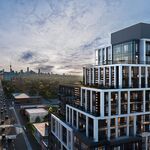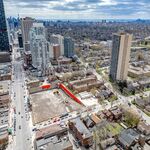Avenue
Active Member
Condo meltdown won't just happen without a significant economic downturn. Things don't exist for your amusement.
Condo meltdown won't just happen without a significant economic downturn. Things don't exist for your amusement.
I wouldn't count on it. Maybe you can't imagine it happening here, but it's already in full swing in London, UK. The entire housing market , with some pleasant exceptions (the previously derelict north is building, a good part due to affordable prices). At this time, the UK is the fastest growing G7 nation economically. That's about to hit a brick wall, but I digress...Condo meltdown won't just happen without a significant economic downturn. Things don't exist for your amusement.
http://www.businessinsider.com/lond...ouse-prices-in-capitals-bloated-market-2017-3London's bloated housing market shows further signs of stalling
LONDON — A growing number of home sellers across London are slashing asking prices for houses as the capital's bloated market shows further signs of stalling.
According to online estate agent Zoopla, the percentage of sellers who cut asking prices had grown in all but two of London's 33 boroughs in January this year compared with July 2016.
That indicates weakening demand and issues with affordability in a market where the average house currently costs an eye-watering £486,000, compared to the national average of £205,800.
Take a look at the chart below, which uses Zoopla data provided to Business Insider and originally compiled for a Bloomberg report ( ...continues with graphs and stats...)
UK Budget to reveal sharp upgrade to economic forecasts
Philip Hammond will be able to reveal a sharp upgrade to this year’s economic forecasts in Wednesday’s Budget and a corresponding increase in his £27bn war chest for either smoothing the path towards Brexit or doling out pre-election sweeteners.
The upgrades will show a significant reduction in borrowing and close to 2 per cent growth in Britain’s economy in 2017. This reflects the momentum in the economy from late 2016 which was not captured in the Autumn Statement and still exists despite the closely watched service sector PMI showing weaker activity in February.
Read more here
Exactly right, albeit the Bay Area is a study in itself for unaffordability.Most Bay Area neighbourhoods have done an exceptional job of suppressing development despite high demand for development. It can be done, but not without other consequences.
Exactly right, albeit the Bay Area is a study in itself for unaffordability.
It was insane how those apartment buildings got built on High Park in the first place when the rest of the street has houses. I could only imagine the beautiful houses that had to come down for those ugly buildings
Boy I can;t wait until the condo meltdown happens
Exactly right, albeit the Bay Area is a study in itself for unaffordability.
That's the consequences part - and this case study fits the current situation to a T:
http://www.citylab.com/housing/2017/02/renters-in-expensive-cities-are-all-about-nimbyism/516021/
AoD
And that is why I find it outrageous that NIMBYs force developers building townhouses to revert to single-detached homes.
You do realise this is a NIMBY thread, right?its easy to say when its not your neighbourhood.
https://www.thestar.com/news/gta/2016/01/02/youre-a-toronto-nimby-now-what.htmlThe good and bad of Toronto NIMBYism
It’s an acronym for Not In My Back Yard, the name given to those who — rightly or wrongly — oppose change in their neighbourhoods. Chances are you are one. In a three-part series, Star columnist Edward Keenan explores both the necessary and the absurd of NIMBYism in Toronto.
By Edward KeenanColumnist
Sat., Jan. 2, 2016
Earlier this fall, signs went up in the window of a former Sleep Country store in the affluent community of Leaside indicating that the “Jefferson Homeless Shelter” would open soon. What happened next was the least surprising thing you can imagine.
People flipped out. Local community news blogger Ted Stuebing told the Star at the time that he and local politicians were inundated with concerned calls. “People were very upset, people were crying,” he said.
Many called the posted number to complain. “How did you possibly, possibly get the permission to ruin the neighbourhood by putting a homeless shelter around here?” one asked.
It turned out to be an awareness-raising hoax: the anti-homelessness organization Raising the Roof made a video of the reactions to drum up support for long-term solutions to homelessness, so no one would need a shelter in their neighbourhood. Meanwhile, in newspapers, on social media, on talk radio, we all had a good laugh at the wealthy residents of Leaside, heartlessly insisting the “drug addicts and drunks” belong somewhere — “down south, or up north” — anywhere else.
Hahahahaha! What a bunch of small minds! Right?
“I’m a very tolerant person but this, just, really, is going over the edge,” one self-parodying woman says in the video, summing up both the precious self-regard and devastating lack of self-awareness common to such neighbourhood complaints.
There’s a word for this, of course: NIMBYism, from the phrase not in my backyard.
Everyone loves to make fun of NIMBYs, dismiss them, look down on them. The thing of it is, while the spotlight here was on Leaside residents, next time it could be you, or me, or virtually any of us. Indeed, the whole hoax depended on the complete predictability of the NIMBY reaction.
Pretty much across Toronto, whether we’re talking about homeless shelters or highrise condos or new umbrellas in children’s parks, a NIMBY reaction has become the most predictable thing in the world. Everyone, it seems, likes their own backyard just the way it is. No one, it seems, wants their own neighbourhood to change.
Right now in Toronto, there are reportedly residents in New Toronto “up in arms” about a rumoured methadone clinic on Lake Shore Blvd.; Cliffside homeowners fighting the scourge of sidewalks; Agincourt neighbours angry about a new bus garage; citizen groups from Ossington to Eglinton fighting the construction of duplexes and lowrises.
And in my experience, if you talk to the people involved, each of them will loudly claim that theirs is not a case of NIMBYism.
You don’t understand! In my case, they want to put this new thing in my backyard! And I’m saying, my backyard is special, it’s a terrible place for this proposed thing, they should put it somewhere else. I’m saying, NOT IN MY BACKYARD! You see? That is very different from NIMBYism.
I paraphrase slightly.
And the thing of it is, sometimes they have a point. I say that as someone who has sometimes made a cottage industry of making fun of NIMBY whining. In some instances, this kind of resident fighting is necessary, and winds up making the city a better place. I’ll explore that concept in a bit more depth in the next instalment of this series.
Right now, the observation I want to make is that if virtually everyone who engages with proposed changes to their neighbourhood is a NIMBY by someone’s definition (and they are), then the term ceases to be useful. I think we need a useful way to identify bad NIMBYism, a framework for assessing the kinds of complaints that are not worth taking seriously, precisely because politicians and decision-makers do not often make such distinctions.
To the ears of a politician, a group of residents whining loudly is the sound of a squeaky wheel on the re-election-mobile. By that metric, the volume of complaints is far more important than their legitimacy.
But gauging their legitimacy is actually necessary, because opposition to change and growth can, in the aggregate, make cities less affordable (see San Francisco’s anti-housing policies), less able to handle growth (see Toronto’s own transit fiascos), and more unequal (see generations of policy hiving off low-income people and services for the vulnerable into ghettos).
That's where this string started. It seems to have ended up somewhere else.In light of the various cases of NIMBYism that borders on the asinine, here is a new thread to deposit choice examples. One from the Star just now:
http://www.thestar.com/news/gta/2015/07/07/left-field-brewery-called-very-bad-neighbours.html
Complaining about weekend noise with a baby? Oh dear, that's going to get somewhere.
AoD
That's a fair point, albeit addressed somewhat in the article, last paragraph. Got to run here, but you open up a new way of looking at this, as do the second and third links my post prior:Unless you're the Density Creeps types.
AoD
That's a fair point, albeit addressed somewhat in the article, last paragraph. Got to run here, but you open up a new way of looking at this, as do the second and third links my post prior:
*Can we avoid vertical density neighbourhood intrusion if we intensify more at present height envelope*?
That still allows for four, if not five floors...
I'm going to have to digest your question further to fully get your point, but an immediate point I've been meaning to make is *light availability*! You can only cram in so many high-rises before it markedly reduces the light available to others. I'll detail and reference more on that point later.But what makes ultimately marginal intrusion in "stable neighbourhoods" worth so much more - to the point that OMB is willing to "design" it for the proponent for approval - than relatively more massive intrusion in "apartment neighbourhoods"? Other than the unspoken class aspect?
AoD




